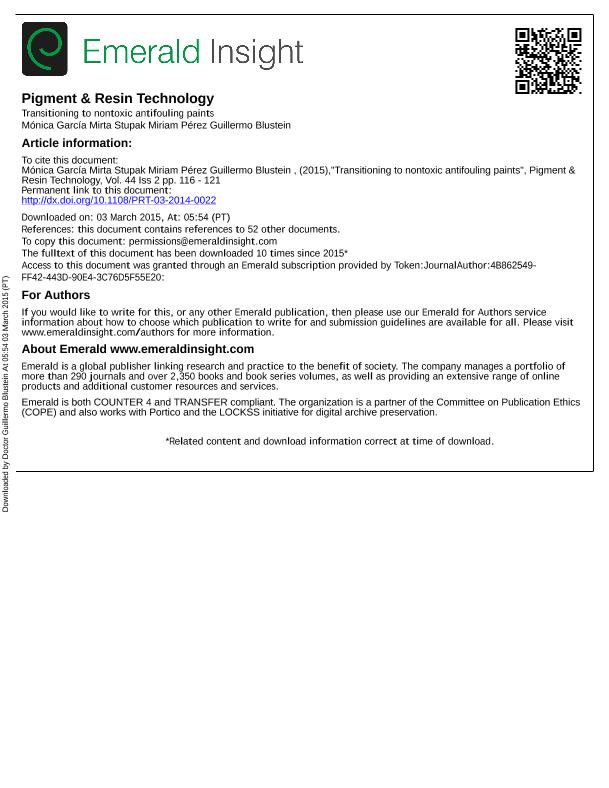Artículo
Transitioning to nontoxic antifouling paints
Fecha de publicación:
01/2015
Editorial:
Emerald Group Publishing Limited
Revista:
Pigment & Resin Technology
ISSN:
0369-9420
Idioma:
Inglés
Tipo de recurso:
Artículo publicado
Clasificación temática:
Resumen
Purpose – The purpose of this paper is to reduce the amount of copper in antifouling paints by using eugenol as an additive. Biofouling leads to deterioration of any submerged material. The most widespread method for control is the application of cuprous oxide antifouling paints which are toxic. First of all, the paper describes the effect of eugenol on larvae of Balanus amphitrite (fouling organism) under laboratory conditions and then the preparation, application and performance of different types of antifouling paints in field trials.
Design/methodology/approach – Three types of soluble matrix antifouling paints were prepared with different pigments. The first one containing 16 per cent v/v copper, the second with 1.6 per cent copper and the third with 1.6 per cent copper 2 per cent eugenol.
Findings – After 12 months of immersion in Mar del Plata harbour paints containing 1.6 per cent copper eugenol and 16 per cent copper were the most effective. Although these formulations showed a similar performance, copper eugenol-based paint contains 90 per cent lesser copper than a traditional copper-based formulation.
Originality/value – The use of antifouling paints with copper eugenol combination as pigment is a promising alternative due to its performance, low cost and reduction in copper leaching to environment.
Palabras clave:
Copper
,
Organic Compounds
,
Antifouling Paints
,
Marine Biology
,
Micro-Organisms
Archivos asociados
Licencia
Identificadores
Colecciones
Articulos(CIDEPINT)
Articulos de CENTRO DE INV EN TECNOLOGIA DE PINTURAS (I)
Articulos de CENTRO DE INV EN TECNOLOGIA DE PINTURAS (I)
Citación
García, Mónica; Stupak, Mirta Elena; Perez, Miriam Cristina; Blustein, Guillermo; Transitioning to nontoxic antifouling paints; Emerald Group Publishing Limited; Pigment & Resin Technology; 44; 2; 1-2015; 116-121
Compartir
Altmétricas




